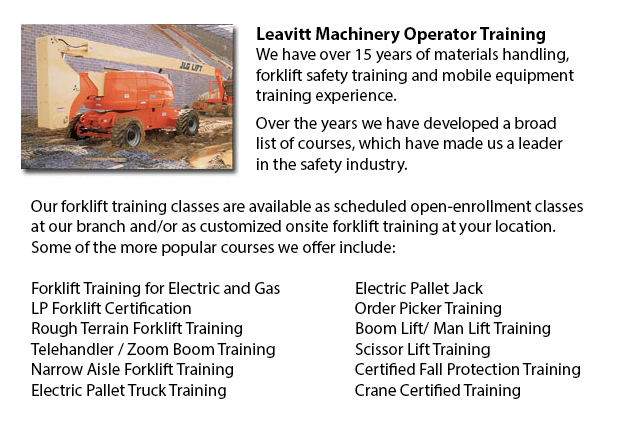
Brampton Manlift Training - Different manlift training programs consist of the review and content of manlift devices. An important part of the course is the practicum where students show their knowledge and practical ability to safely operate a manlift. A requirement to Manlift training is the fall protection training, that may be included in the training according to the particular needs of the client.
Course Content
The program content consists of: the effect of performing unsafe acts or utilizing unsafe machinery, pre-shift machine inspection and work area survey requirements, Lifting device machine definitions, Review of load capabilities, safety decals and specific equipment requirements, Review of related parts of the CSA Standards as well as the OHSA Standards and Review site specific Hazards, together with controls for safely using a lifting device.
Demonstration and Evaluation Content
The evaluation and demonstration portion of the course consists of: Using a spotter or a signaler when needed; Proper personal protective equipment or P.P.E. as required; Utilizing the right fitting harness or fall arrest devise; Making use of a lift only on solid and level ground; Using the lift with all other staff clear of the job place; Aware of load restrictions etc. and other specs as set out by the manufacturer; Pre-shift work area survey and equipment inspection; Having all associated machinery stored safely on the lift platform; Isolating off the work place when major work projects are to be done; and ensuring a smooth and safe operating speed for different plant conditions
Each and every person will be tested to make sure they can efficiently and safely use your site-specific machine.
Manlift Safety
Because the manlift is capable of lifting materials and personnel more than 20 feet in the air, these equipment pose a particular amount of danger and can be dangerous machinery if not operated correctly. Since the danger is so apparent, lift owners and operators are careful to properly maintain their equipment and follow correct safety measures and operating procedures. The ratio of accidents involving this particular machinery is quite low.
The safe use of the boom lift, scissor lift and the manlift is up to the operator of that equipment. They must understand all of the responsibilities that go with running the machine and how to use the lift vehicle safely. The most basic safety features on the machine are the operating guidebook and safety decals. These show vital information regarding the operating procedures, safety machinery and maintenance.
Newer lift models will come along with guidebooks and decals in place. Technically, the operating manual must be stored on the lift itself. If you are buying a second-hand lift, it is vital to make certain that the instruction booklet is included and that vital decals haven't been painted over. The restraints which prevent operators from falling and the guardrails are other essential safety features. These are mandatory and standard on all types of lifts.
-
Brampton Aerial Boom Lift Ticket
Brampton Aerial Boom Lift Ticket - Aerial lift trucks might be used to accomplish several different tasks executed in hard to reach aerial places. Many of the tasks associated with this style of jack include performing routine maintenance on building... More -
Brampton Aerial Lift Train the Trainer
Brampton Aerial Lift Train the Trainer - The Aerial Lifts Train the Trainer Certification Program would teach trainers how to efficiently train operators in safe industrial mobile equipment operation. Trainers are provided with in-depth instruction o... More -
Brampton Zoom Boom Training
Brampton Zoom Boom Training - Zoom Boom Training is intended to train operators on variable reach forklifts. The goals of the training are to be able to impart an understanding of the physics of the machinery, and to be able to outline the operator's... More -
Brampton Heavy Equipment Operator Training
Brampton Heavy Equipment Operator Training - Heavy equipment operator training facilities that provide good standards within the industry, providing field performance work and additional machinery training are really sought after training features. S... More -
Narrow Aisle Forklift / Order Picker Training / Electric Pallet Jack / Electric Pallet Truck Training in Brampton
A pallet haul is equipment built in particular for moving pallets of irregular weights and dimensions. They may be used in conjunction with cranes, forklifts and other heavy duty equipment as an appendage piece or to be employed on their own. Pallet... More -
Brampton Overhead Crane Safety Training
Brampton Overhead Crane Safety Training - Overhead crane safety training equips operators with knowledge and skills regarding crane safety measures, accident avoidance, materials handling, and equipment and stock protection. Trainees will learn the k... More -
Brampton Crane Safety Training
Brampton Crane Safety Training - Companies and crane drivers have to know the problems associated to crane safety. Legislation provides rules for the safe maintenance, operation and inspection of lifting machines across North America. Crane Safety co... More -
Brampton Telehandler Training
Brampton Telehandler Training - Telescopic handlers normally known as telehandlers for short, are a really popular piece of heavy construction machinery. They are usually utilized in the construction and agricultural trades. These machines have farth... More

Forklift Certification Brampton
TOLL FREE: 1-888-254-6157
Brampton, Ontario
forkliftcertificationbrampton.com
Email Us
About Us


